The three main classifiers of genus, species, and cultivar allow gardeners to properly identify and differentiate plants that may appear related. For example, Sedum glaucophyllum is the Appalachian stonecrop that grows best in rocky alkaline soil. It belongs to the Sedum genus, and its species is glaucophyllum. A cultivar further differentiates this plant by referring to specific traits. For instance, ‘Dazzleberry’ would produce a burgundy-colored plant rather than a green one.
Comparing Sedum vs. Succulent
Succulents are not an official botanical classification but instead refer to plants with thickened leaves or stems that allow them to retain water even in arid climates or conditions. Succulents can be found within other genera, such as sedums (which belong to the Crassulaceae family) as well as cacti (belonging to Cactaceae). The key difference between these two types of succulent-containing plants is the presence of thorns on cacti. However, this distinction isn’t always clear cut, and there are wide varieties of both types with similar features due to their adaptations for surviving dry weather.
For those who wish to cultivate drought-resistant gardens, there are numerous sedum, cactus, and succulent cultivars available with different body forms ranging from low-growing annuals, perennials and herbs all the way up to tall shrubs. They look beautiful while requiring minimal care once established!
Key Differences
The key difference between succulents vs. sedums is that Sedum is a genus of plants, and succulents are not. The word succulent is an adjective used to describe many types of plants that store water from many different plant families.
In other words, the word succulent is a general word to describe a plant that stores water. But the word Sedum is used only to describe plants from the specific Sedum plant family.
Root Succulents
Root succulents are a type of plant that has adapted to store water in their roots rather than in their stems or leaves. These plants have adapted this way because they typically grow in arid climates, where there might not be regular access to water and rainfall is sparse. Examples of root succulents include Calibanus hookeri, Fockea, Kedrostis, and Dioscorea.
Root succulents generally require little watering as the soil should remain dry for much of the year until it’s time for them to bloom again. Although these plants may not need much tending throughout the growing season, they do benefit from occasional deep watering sessions during hotter months when it’s possible for them to get dried out more quickly.
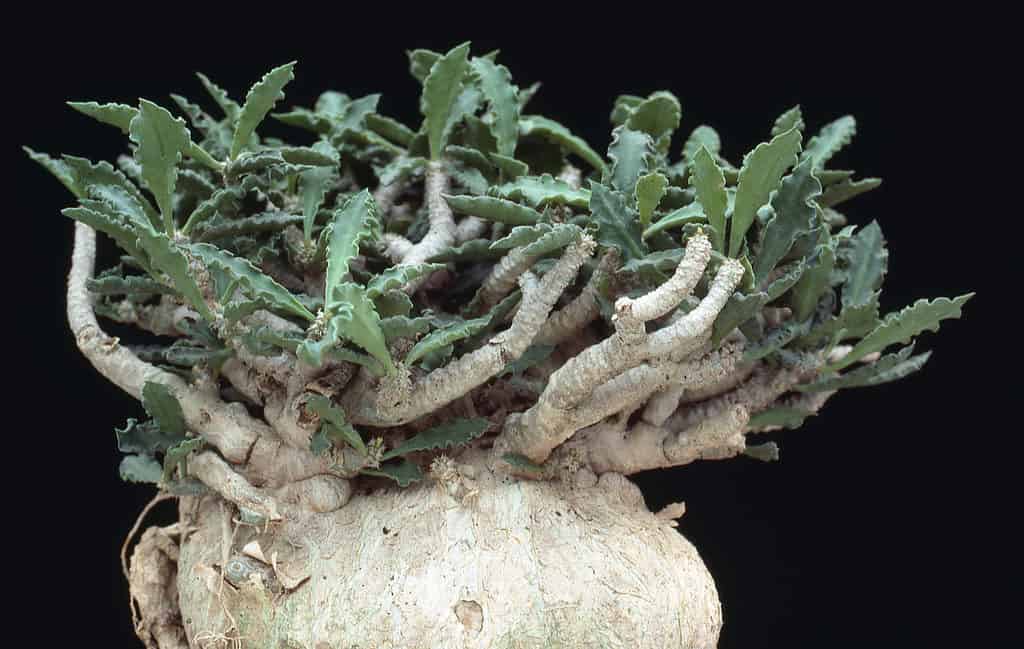
©COULANGES/Shutterstock.com
Stem Succulents
Stem succulents, also known as caudiciforms, are plants that store water in their stems. Popular examples of stem succulents include cacti, Adenium, and Pachypodium. Cacti are characterized by having spines rather than leaves. They come in a range of shapes and sizes, from small barrel cacti to towering saguaros. Adeniums have thick trunks with swollen bases. They produce beautiful flowers in shades of pink or white. Lastly, pachypodiums are tall-growing plants with spiny branches and gorgeous blooms ranging from yellow to purple. All three types of stem succulents require similar care conditions, lots of bright light, and little water, making them ideal for dry climates or those who don’t want to spend too much time tending to their indoor garden!
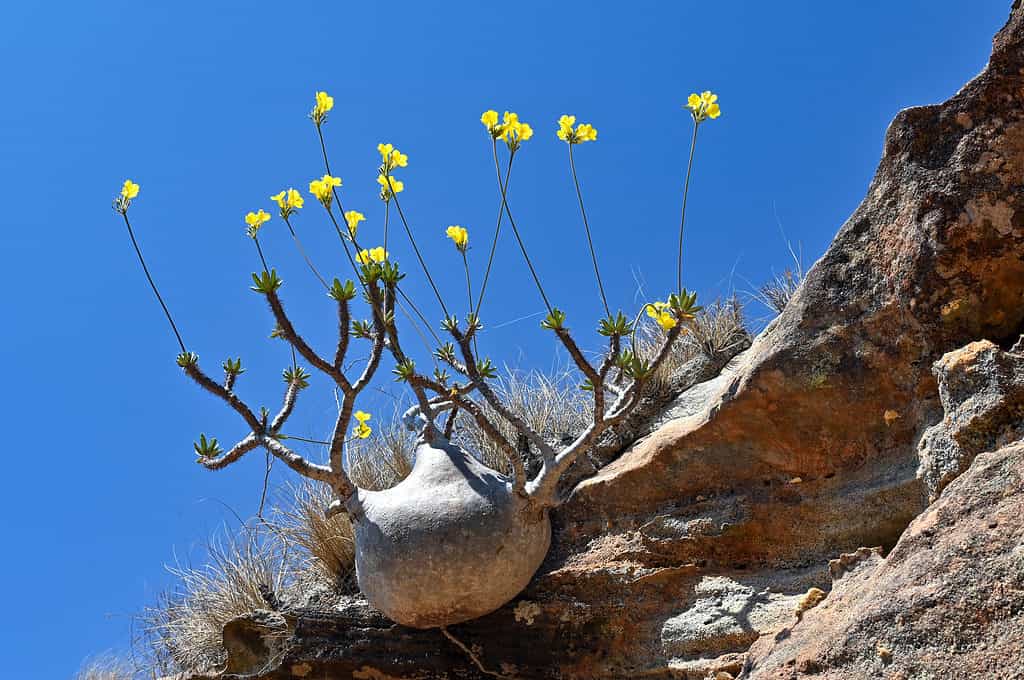
©iStock.com/mirecca
Leaf Succulents
Leaf succulents are a type of plant that store water in their thick and fleshy leaves. They can often be found growing in arid climates, like deserts or rocky areas with little soil. Examples of leaf succulents include Sedum, Sempervivum, Aloe, and Agave. These plants require minimal water and care to survive. They are drought-tolerant and need very little maintenance once established. The typical lifespan of these plants is between 5-10 years, depending on the species used. Leaf succulents come in a variety of shapes and sizes as well as different colors, including green, yellow, white, purple, and orange, making them an attractive addition to any garden or home decor setting.
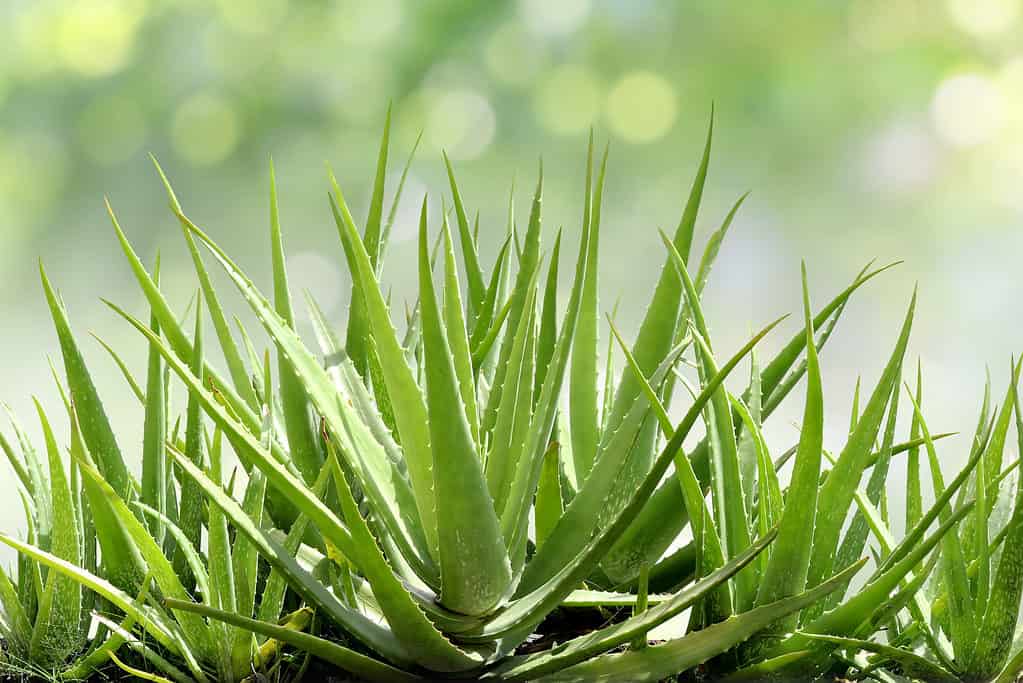
©iStock.com/cgdeaw
Combination Succulents
Combination succulents like jades are an interesting type of plant that can store water in both their stems and leaves. This helps them to survive in arid climates with little rain or water, as they can still access the moisture stored away in their stem and leaf tissues. Jades have thick, fleshy stems that allow for maximum storage potential without becoming too heavy for the plant. These unique plants offer a great addition to any garden or indoor space due to their ability to store so much water and thrive even under extreme conditions.
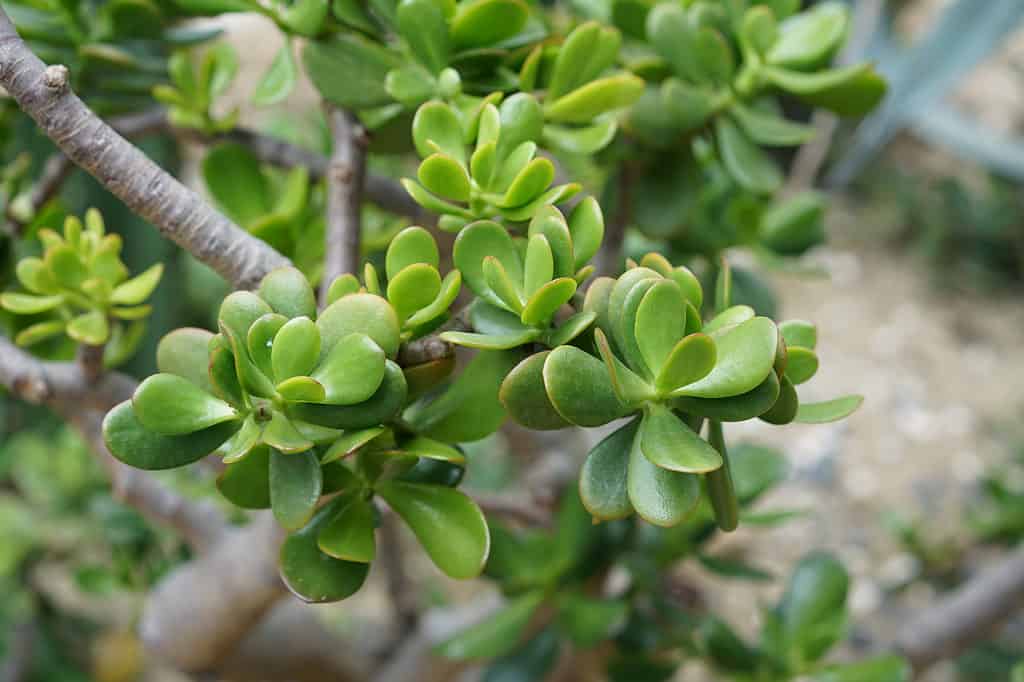
©iStock.com/Wirestock
Types of Sedums
Sedum is a large genus of succulent plants that includes over 600 species. These plants are found in a wide range of habitats, from deserts to mountains and even in tropical rainforests. Sedums come in an array of shapes and sizes, ranging from ground-hugging mats to tall shrubs. Most sedums have thick, fleshy leaves that help them store water for long periods of time without needing additional moisture. Commonly referred to as “stonecrops,” many types of Sedum are valued for their vibrant flowers, which bloom during the summer months and can last until fall if they’re taken care of properly. Here are a few of our favorites below.
Sedum acre – Also known as gold moss stonecrop or mossy stonecrop, is a tufted evergreen perennial that typically grows from 2 to 5 inches in height. The stems are short and semi-prostrate most of the year, but they become erect when the plant flowers in summer. The leaves are fleshy with a rounded tip, and they may be tinged with red. The star-shaped flowers form a cluster of three to six blossoms, each with five yellow petals. Touching the leaves can cause skin rashes due to the acrid fluid they contain.
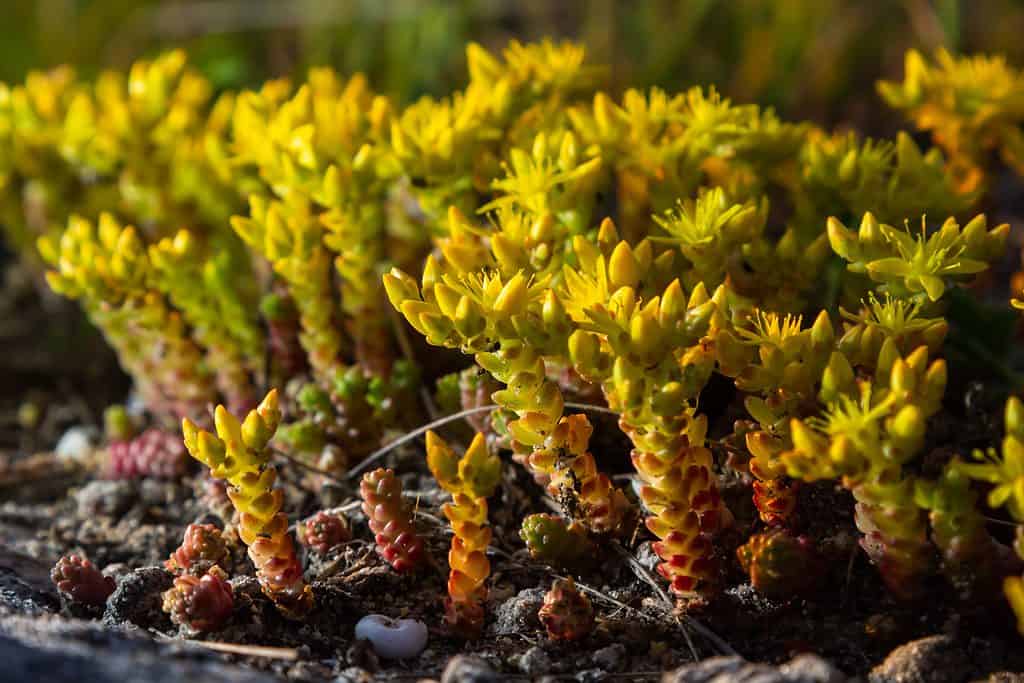
©olko1975/Shutterstock.com
Sedum album – Often called white stonecrop. It is found in temperate regions and crows in rocky soil and stone crevices. It is green most of the year and produces white star-shaped flowers in late summer. It is low-growing and vigorous, growing quickly to cover a rock wall or rocky bank.
Sedum dasyphyllum – Also called Corsican stonecrop. It is a low-growing succulent plant that is perennial. It has turquoise leaves and long creeping stems. White flowers are produced in summer. It grows in the Mediterranean regions, usually in rocky areas.
Sedum reflexum – Common name is Jenny’s stonecrop or blue stonecrop. It is native to nearly all of Europe. It has sprawling stems with soft tissue. The leaves are blueish-gray, and the flowers are yellow. It is commonly grown as a container plant, a houseplant, and in rock gardens.

©iStock.com/surotbar
Sedum ternatum – The common name is woodland stonecrop. It blooms with white flowers in spring and is tolerant of shade. It grows in the understory of the forest, on top of boulders, and in gardens across the eastern United States.
Sedum spathulifolium – Usually called yellow stonecrop. This plant grows across the western side of North America. It has thick flesh stems and silver leaves that grow in a rosette form. In the summer, yellow flowers erupt in stark contrast to the silver-gray leaves.
Sedum sarmentosum – Known commonly as stringy stonecrop and graveyard moss. It is a perennial sedum that grows across China, Korea, and Thailand. The evergreen leaves are bright green, and the flowers are a rich yellow with five petals. It is a trailing plant that looks beautiful in a hanging basket.
Sedum caeruleum – Commonly called baby-blue stonecrop. It has red stems and leaves and pale blue flowers that are shaped like stars. It grows in northwest Africa.

©iStock.com/Wirestock
Up Next
- 10 Types of Sedum Succulents
- Types Of Indoor Succulents
- Burro’s Tail vs Donkey Tail: What’s the Difference?
The post Sedum vs. Succulent: What is the Difference? appeared first on AZ Animals.
from Animal News, Facts, Rankings, and More! - AZ Animals https://ift.tt/TUV5Wk9